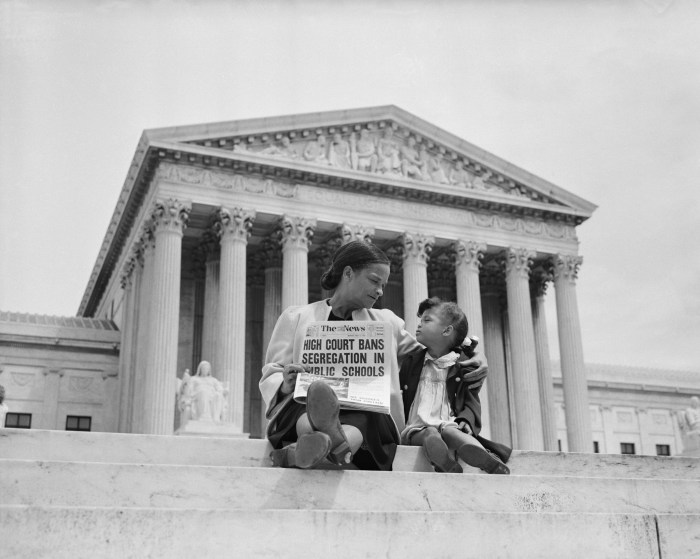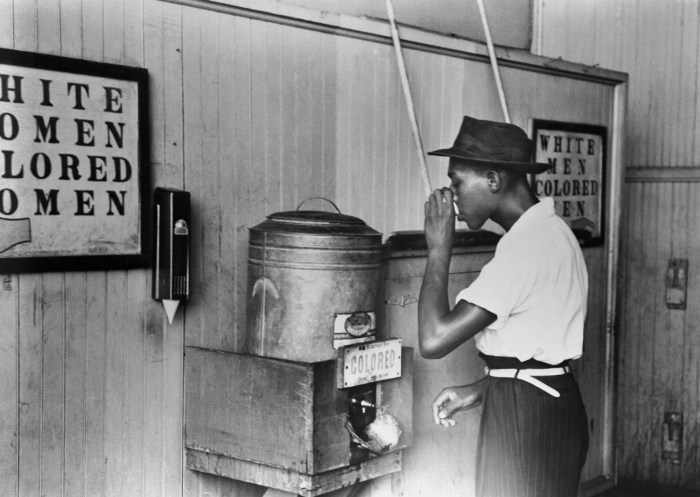
What Did Jim Crow Laws Do? sets the stage for this enthralling narrative, offering readers a glimpse into a story that is rich in detail and brimming with originality from the outset. The Jim Crow laws, a system of state and local laws enacted in the Southern and some border states of the United States between 1877 and the mid-1960s, were designed to disenfranchise and segregate African Americans. These laws, named after a minstrel show character, were deeply rooted in racism and aimed to solidify white supremacy after the Civil War. They systematically stripped African Americans of their civil rights and created a society where segregation and discrimination were deeply embedded in everyday life.
From the moment they were enacted, Jim Crow laws had a profound impact on African Americans. They were denied basic rights like voting, access to quality education, and the opportunity to live in safe and integrated neighborhoods. The laws fostered a climate of fear and intimidation, with African Americans constantly facing the threat of violence and oppression. Jim Crow laws cast a long shadow over American history, creating a legacy of systemic racism that continues to affect African Americans today.
Resistance and Activism

Despite the harsh realities of Jim Crow, African Americans refused to succumb to oppression. They actively resisted the laws and their enforcement through various forms of protest, challenging the system and laying the groundwork for future civil rights movements.
Forms of Resistance
African Americans employed a wide range of tactics to resist Jim Crow laws, demonstrating their resilience and determination.
- Boycotts: African Americans organized boycotts of businesses that practiced segregation, targeting discriminatory practices and demanding equal treatment. The Montgomery Bus Boycott, led by Dr. Martin Luther King Jr., is a prime example of this strategy, which lasted for over a year and ultimately led to the desegregation of public transportation in Montgomery, Alabama.
- Legal Challenges: African American leaders and organizations pursued legal challenges to Jim Crow laws, arguing that they violated the Constitution. The NAACP (National Association for the Advancement of Colored People) played a pivotal role in this effort, successfully challenging segregation laws in various court cases, including Brown v. Board of Education (1954), which declared state-sponsored segregation in public schools unconstitutional.
- Civil Disobedience: Acts of civil disobedience, such as sit-ins, marches, and freedom rides, were employed to challenge Jim Crow laws and highlight the injustice of segregation. The Greensboro sit-ins, initiated by four African American students in 1960, are a classic example of this form of resistance, leading to the desegregation of lunch counters across the South.
- Self-Defense: African Americans faced violence and intimidation from white supremacists. In response, they formed self-defense organizations to protect their communities and fight back against racist attacks. The Black Panther Party, established in 1966, is a notable example of a group that advocated for self-defense and community empowerment.
- Cultural Resistance: African Americans also resisted Jim Crow through cultural expressions. They created and preserved their own distinct culture, music, literature, and art, showcasing their resilience and identity despite the oppressive environment. The Harlem Renaissance, a flourishing period of African American art and culture in the 1920s, is a testament to this form of resistance.
Key Individuals and Organizations
Several individuals and organizations played a crucial role in challenging Jim Crow laws, leading the fight for racial equality.
- Dr. Martin Luther King Jr.: A prominent leader of the Civil Rights Movement, Dr. King advocated for nonviolent resistance and led numerous protests, marches, and boycotts, inspiring millions with his message of equality and justice. His leadership was instrumental in the passage of the Civil Rights Act of 1964 and the Voting Rights Act of 1965.
- Rosa Parks: Her refusal to give up her seat on a Montgomery bus to a white man in 1955 sparked the Montgomery Bus Boycott, a pivotal moment in the Civil Rights Movement. Parks’ act of defiance became a symbol of resistance against segregation and inspired countless others to join the fight for equality.
- The NAACP (National Association for the Advancement of Colored People): Founded in 1909, the NAACP played a crucial role in challenging Jim Crow laws through legal battles, advocating for equal rights, and organizing protests. The organization’s efforts led to significant victories, including the Brown v. Board of Education decision.
- The Student Nonviolent Coordinating Committee (SNCC): Established in 1960, SNCC played a key role in organizing sit-ins, freedom rides, and voter registration drives, empowering young African Americans to actively challenge segregation and fight for their rights.
- The Southern Christian Leadership Conference (SCLC): Founded in 1957, SCLC, led by Dr. Martin Luther King Jr., focused on organizing nonviolent protests and campaigns to dismantle segregation and promote racial equality. The organization played a pivotal role in the Civil Rights Movement, advocating for the passage of key civil rights legislation.
Impact of Resistance Movements
The resistance movements against Jim Crow laws had a profound impact, ultimately leading to their dismantling.
- Passage of Civil Rights Legislation: The tireless efforts of activists and organizations, through protests, legal challenges, and boycotts, created pressure on the government to address racial injustice. This pressure led to the passage of landmark legislation, including the Civil Rights Act of 1964 and the Voting Rights Act of 1965, which outlawed segregation and discrimination based on race, color, religion, sex, or national origin.
- Shift in Public Opinion: The resistance movements, through their courageous actions and unwavering commitment to equality, raised awareness of the injustices of Jim Crow and shifted public opinion. The brutality and discrimination faced by African Americans became increasingly visible, garnering national attention and prompting a growing demand for change.
- Empowerment of African Americans: The resistance movements empowered African Americans, fostering a sense of collective identity and purpose. They provided opportunities for African Americans to take control of their destinies, challenge the system, and fight for their rights, contributing to the growth of a strong and resilient Black community.
Legacy of Jim Crow Laws

The Jim Crow era, though officially ended in the mid-20th century, continues to cast a long shadow over American society. The discriminatory laws and practices that defined this period left a lasting impact, creating systemic inequalities that persist to this day. This section explores the enduring legacy of Jim Crow and its multifaceted consequences.
The Continuing Impact of Jim Crow, What did jim crow laws do
The legacy of Jim Crow is not confined to the past. Its effects continue to shape the present, manifesting in various forms of social, economic, and political disparities. These disparities are not mere historical relics but deeply embedded in the fabric of American society, perpetuating cycles of disadvantage for generations.
- Racial Wealth Gap: Jim Crow laws, particularly those restricting property ownership and access to loans, significantly contributed to the racial wealth gap. This gap, which represents the difference in accumulated assets between white and Black households, has persisted and even widened in recent decades. The legacy of Jim Crow continues to limit opportunities for economic advancement for Black Americans, perpetuating a cycle of poverty and financial insecurity.
- Discrimination in Housing: Redlining, a discriminatory practice rooted in Jim Crow era policies, has had a lasting impact on housing patterns and segregation in the United States. Redlining, which involved denying loans or insurance to residents of predominantly Black neighborhoods, created a system of unequal access to housing and limited opportunities for homeownership for Black Americans. This has resulted in concentrated poverty and a lack of access to quality housing in many Black communities.
- Mass Incarceration: The War on Drugs, a policy with roots in the Jim Crow era, has disproportionately impacted Black communities, leading to mass incarceration. The criminal justice system has been used to target and criminalize Black Americans, resulting in higher rates of arrest, conviction, and imprisonment for drug offenses. This has had devastating consequences for Black families and communities, contributing to the cycle of poverty and social exclusion.
- Political Disenfranchisement: Jim Crow laws systematically disenfranchise Black voters through tactics like poll taxes, literacy tests, and grandfather clauses. While these explicit forms of disenfranchisement have been outlawed, their legacy continues to manifest in subtle forms of voter suppression, such as voter ID laws and gerrymandering, which disproportionately impact Black voters. This has limited Black political participation and representation, undermining their ability to advocate for their interests and challenge systemic inequalities.
Closing Notes

The Jim Crow era was a dark chapter in American history, but it also served as a powerful catalyst for resistance and activism. African Americans, despite facing immense hardship, organized, protested, and fought for their rights. Their courage and determination, coupled with the tireless efforts of allies, ultimately led to the dismantling of Jim Crow laws. However, the legacy of Jim Crow continues to be felt today in the form of persistent racial disparities in areas like education, healthcare, and criminal justice. Addressing these inequalities requires a deep understanding of the historical roots of racism and a commitment to dismantling the systems that perpetuate it.
General Inquiries: What Did Jim Crow Laws Do
What were some specific examples of Jim Crow laws?
Jim Crow laws varied by state, but some common examples include poll taxes, literacy tests, grandfather clauses (which exempted white voters from these restrictions), and separate waiting rooms, restrooms, and drinking fountains for Black people.
How did Jim Crow laws impact the economy?
Jim Crow laws limited economic opportunities for African Americans, leading to widespread poverty and a widening wealth gap. They were denied access to decent housing, quality education, and good-paying jobs, creating a system that perpetuated economic inequality.
What was the role of the Supreme Court in upholding Jim Crow laws?
The Supreme Court played a significant role in upholding Jim Crow laws through decisions like Plessy v. Ferguson (1896), which established the “separate but equal” doctrine. This doctrine, which legalized segregation, allowed for the creation of a system of racial discrimination that lasted for decades.
How did Jim Crow laws contribute to the Civil Rights Movement?
The injustices and inequalities created by Jim Crow laws fueled the Civil Rights Movement. The movement emerged as a direct response to the oppressive system of segregation and discrimination. Leaders like Martin Luther King Jr. and Rosa Parks led nonviolent protests and boycotts, challenging Jim Crow laws and advocating for equal rights for all Americans.




